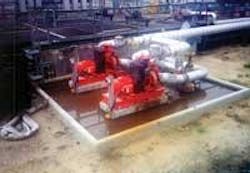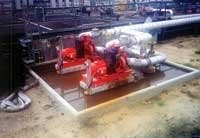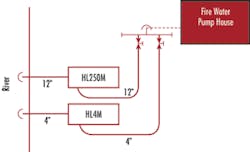Critical Pumping: When Redundancy Isn’t Enough
By Peter Snow
A North Carolina power company supplied fire water to its facility via an electric driven vertical turbine pump - that is until it failed. Adding to the difficulty of the situation, the small jockey pump tasked with maintaining pressure on the fire water line failed as well. To make matters even worse, neither pump had a redundant spare.
Both pumps needed to be pulled for complete overhauls. The power company contacted Godwin Pumps of America Inc., one of the world’s largest manufacturers and suppliers of rental portable pumping equipment. Representatives at Godwin’s local rental branch in Charlotte, N.C., responded immediately with a complete portable pumping system.
One might think the solution was to include spare pumps to back up the system in case of failure. While a common practice, this built-in redundancy may not necessarily offer the most efficient or practical alternative.
Outside the Box
Consider the following statement: “Continuous operation requires reliable pumping.” The pursuit of those five words has defined the careers of many maintenance engineers and rotating equipment experts. Exactly how to achieve and maintain reliable pumping provides an ongoing dialogue of ideas and philosophies, both mechanical and economic.
Pumps are the second most used machines on the face of the planet, ranking only behind electric motors. And electric motors with their basic design and function enjoy a greater degree of reliability. Pumps are quite another story. The wide variety of products, flows, pressures and temperatures make reliable pumping one of the foremost goals of any continuously operating industry.
Thus we return to the statement: “Continuous operation requires reliable pumping.” So what is the predominant approach to meeting this ever-challenging goal? Redundancy. If the failure of one pump affects production, engineer a spare as part of the operation. This, however, begs yet another question. What happens when redundancy isn’t enough?
Conventional Wisdom
Driven by the dual goal of continuous and economic operation, industrial plants most often choose the route of a primary and spare pump for critical applications. Should the primary pump fail, the spare pump (equally rated) takes over and operations continue. To gain additional life from the pumpsets, many plants employ a rotation of equipment to regularly switch between the primary and the spare pump, so that each pump has the opportunity to run. Through such rotation programs, time between maintenance outages potentially doubles. Still, there are benefits and liabilities to this approach. As mentioned, the benefit is reduced frequency of repair on the primary and standby pumpsets. The liability is the potential for both pumpsets to require maintenance on or about the same time. So at the time when the primary pump is pulled for an overhaul, the spare pump could be ready to fail as well, thereby reducing the reliability of the remaining pump during the primary pump’s outage. Should a failure occur to the remaining pump during a pump outage, there is no spare. The loss of the pump could create operational difficulties, possible production cuts or even loss of service. Given the number of critical pumps in a large industrial facility, adding a third pump for additional redundancy becomes economically unattractive.
Beyond Two-for-One
More and more industrial facilities are using portable pumping technology, once thought as mainly for the construction industry, to increase pumping reliability. For decades, portable diesel-driven pumps have been the mainstay of construction companies providing dewatering capabilities at job sites virtually anywhere. Often trailer-mounted, these portable pumps are found on construction sites and municipal treatments plants around the world.
Pumping applications in the construction and municipal industries call for solids handling and medium head. With flows of construction dewatering projects and sewer bypass applications ranging from 100 to 100,000 gallons per minute (gpm), most portable pump applications have horizontal open discharge designs with medium to low amounts of resistance or Total Dynamic Head (TDH). Conversely, industrial pumping applications such as product transfer, cooling tower pumping, or fire water systems routinely involve greater resistance or higher heads. Technological advances in portable pumping have brought a line of diesel or electric drive high head pumps to the market that can produce up to 250 pounds per square inch (psi) of discharge pressure.
“You mean you have a portable pump that can produce 1,500 gpm at 200 psi discharge head?” a bewildered maintenance engineer stated. Suddenly a whole new world of opportunities opens up:
• The product transfer pump that has been limping along while the primary pump is out for repairs;
• The cooling tower pump that continually burns up a seal every three months;
• The fire water pump that needs an annual maintenance overhaul; and
• The vertical turbine with bearings that failed for the fifth time in a year.
Each pump failure usually is accompanied by a mad scramble to ensure the spare is in good working order, or, if not, around-the-clock repairs are scheduled on the primary pump to get it back up as fast as possible. Continuous operation requires reliable pumping.
The Root Cause
If properly designed, engineered, and operated, pumps are reliable machines. Frequent pump failures are therefore a signal of a problem in the design, engineering or operation of the pump. Finding the root cause may not always be easy. Reliability engineers and rotating equipment experts spend countless hours searching for the sometimes elusive root causes of pump failures. Their conclusions often have one thing in common: regardless of the cause, fixing it properly will take time. Whether it’s re-engineering the piping system, resizing the pump, reducing strain on pump flanges, or changing operational procedures, the fix will take time. Unfortunately, time isn’t always an option in continuously operating facilities utilizing the primary and spare redundancy approach. That is unless a portable pumping system can be installed to temporarily replace the permanent system while time-consuming major repairs or changes are made. High pressure portable pumps with flanged hoses connected on suction and discharge tie in to existing piping to provide a redundant pumping system during major repairs to pump pads and/or piping.
A Stitch in Time
An effective preventive maintenance program for rotating equipment is the goal of all industrial facilities. Yet, how can this be accomplished when equipment is rarely available for routine repair? Not to mention the effort and labor time dedicated to high priority repairs from unexpected failures. The ability to repair a pump before total failure often reduces the time and cost required to return the pump to service. Again, high pressure portable pumping can bring an element of flexibility to a preventive maintenance program by allowing for scheduled outages of critical equipment prior to failure. Repairs are made without jeopardizing reliability.
Automatic Controls
Advances in portable pump control panels now provide the ability to automatically and/or remotely start and stop portable pumpsets based on suction level or discharge pressure. Transducers reading either static level in a tank or discharge line pressure provide automatic response to changing application conditions. With electric drive portable pump applications, variable frequency drive (VFD) control panels allow pumpsets to maintain level or pressure by varying the speed of the electric motor to meet changing conditions. All of the system functionality of permanently installed pump stations now can be replicated with a totally portable pump system.
Back to Carolina
In the case of the North Carolina power company, the failed turbine pump was sized to supply 3,500 gpm at a discharge pressure of 110 psi. The temporary replacement system included a Godwin Dri-Prime® model HL250M 12'' by 10'' high pressure pump driven by a 440 horsepower diesel engine to replace the failed turbine pump. Also supplied was a Dri-Prime model HL4M with 4'' suction and discharge connections (providing flow up to 300 gpm at 110 psi) and powered by a 100 horsepower diesel engine to replace the much smaller jockey pump and maintain line pressure. A pressure transducer on the discharge piping relayed system pressure to the microprocessor control panels on the pumps which, in turn, responded automatically to either maintain system pressure (HL4M) or respond to a need for fire water (HL250M). Priming the pumps wasn’t an issue due to the venturi priming system that automatically self-primes the pump by creating a vacuum in the suction hose.
Conclusion
The increased flexibility gained by using portable pumpsets in place of permanently installed applications gives maintenance and operations departments countless options for increased reliability in critical pumping applications. What was once thought of as construction equipment, new high pressure portable pumps are finding a home in industrial facilities across the country.
About the Author:
Peter Snow is training manager at Godwin Pumps of America Inc., which is based in Bridgeport, NJ. Contact: 856-467-3636, [email protected] or www.godwinpumps.com.



